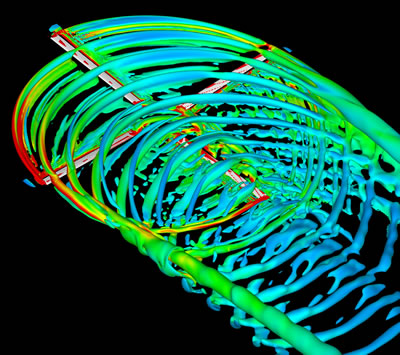In the framework of SHANEL, a joint Franco-German research project financed for Onera by the DPAC [ Aeronautic Civil Programs Agency], specialists in aerodynamics at Onera used the in-house" software package elsA to calculate the blade-vortex interactions on a rotor [rotor Bo 105] during descent flight. A grid of 31 million points was needed in order to calculate the flow domain.
"

Calculation of the blade-vortex interaction on a rotor
Numerical simulation carried out in a grid of 31 million points using the elsA software package.
(DAAP: Thomas Renaud)
The specialists compared the numerical results with the experimental databases HART (1994) and HART II (2001), which were designed to define the aero-acoustic characterization of the rotor in order to validate numerical simulations.
Comparisons between the calculations and the experiments revealed that elsA was able to predict the interactions very accurately. These are definitely the best results obtained on the subject, to date, in terms of conformity with empirical results. It should be stated that having a very detailed knowledge of the interactions between blades and the vortices that they generate (as in this calculation) is mandatory in terms of predicting the performances of a rotorcraft and the noise it generates. For the time being, even though the calculations are not at a point where the results for a whole helicopter can be obtained with this degree of precision, numerical simulation of this type of configuration using elsA shows great potential.




